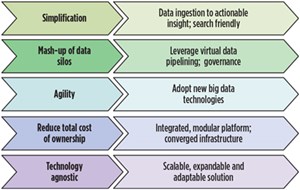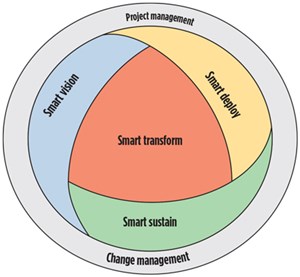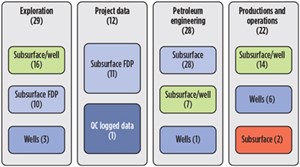Digital transformation with Smart Transform methodology: One NOC’s journey
The current oil and gas (O&G) market has helped national oil companies (NOCs) expand their roles beyond national O&G assets to become international players. As a result, NOCs face the same challenges as international oil companies (IOCs) and other players, as well as additional problems that are specific to NOCs. To remain competitive and address these challenges, NOCs need to embark on a digital transformation journey. This article discusses such a journey undertaken by Petrovietnam Exploration and Production (PVEP), highlighting how digital transformation can fulfill the company’s mission to grow as an NOC, and the proven economic value that was extracted from the company’s unstructured data.
The O&G industry has adopted some digitization of its data for decades and has leveraged that digitalization to some degree during the drilling and production process, usually referred to as “digital oil fields.” Unfortunately, these aspects of the digital journey have provided only incremental value to the industry. However, these two digital journeys’ steps have created a significant amount of untapped assets for the industry—the data. These data will continue to grow in size, complexity and dimensionality, as the O&G industry increases the use of emerging sensors, the Internet of Things (IoT), and other devices that will monitor and operate various aspects of the oil well lifecycle. A McKinsey report in 2014 suggested that the industry only uses 1% of its data assets to create value. Thus, there is an opportunity for the industry to create significant value from the most valuable asset—the data. The value created from the data assets is the digital transformation, which transforms the business through new strategies, products and services, and allows business growth through continuous data-driven innovation.
Digital transformation can help NOCs achieve their goals of expanding their scopes in the global competitive markets. During the last decade, NOC control of global hydrocarbon resources increased from less than 10% in the 1970s to more than 90% by 2012. The high oil prices have provided NOCs with opportunities to increase capital and bid in global markets, to control a larger hydrocarbon share. During the last two decades, NOCs have surpassed their traditional role as the gatekeeper of national O&G resources and become key players in the global market. Typically, NOCs work with three business models:
- Joint ventures (JVs) with IOCs
- Mergers and acquisitions (M&As) of assets globally
- Direct engagement with oilfield service companies (OFSCs) to produce hydrocarbons and control the supply chain.
The increased role of NOCs continues to dominate the global energy landscape. The PVEP mission statement echos the rise of the NOC role in global energy markets: “To become an international oil company, and a leader amongst regional companies, while keeping our high professionalism with global operational capabilities.” To compete and sustain in global markets, PVEP sought transformational change, and thus collaborated with Halliburton to facilitate the change using the proprietary Smart Transform approach.
The Smart Transform methodology was developed by Halliburton to help NOCs and other companies create value and take full advantage of the digital transformation. As mentioned previously, the data of NOCs are the most significant assets, after hydrocarbons. To create value for digital transformation requires a culture of data-driven innovation in the NOCs. This data-driven innovation is defined using the SMART approach, Fig. 1. The next-generation platform from Halliburton is an example, and the first implementation, of an integrated, modular and agile platform to manage E&P big data using the SMART approach, which incorporates the four enablers of E&P big data discussed in the previous section.
Smart Transform expands the SMART approach for the technology platform toward holistic business value creation. The business sides of NOCs requires the Smart Transform tenets to address and create the value proposition. The Smart Transform aspects that are essential for NOCs to grow in the global markets are Smart Vision, Smart Deploy, and Smart Sustain. These phases help guide NOCs through the transformation process to achieve their mission and goals in an agile and efficient manner. Fig. 2 shows the various aspects of the Smart Transform approach.
To achieve digital maturity, PVEP leveraged the following four pillars of digital transformation:
- O&G big data
- Integration of emerging technologies, such as cloud, fog, and others
- Real-time operations
- Automation using Internet of Everything (IoE), sensors, etc.
Like most NOCs, PVEP also faces additional unique challenges, compared to IOCs and other industry competitors, such as growing the national talent pool. PVEP has been in the forefront of nurturing Vietnam’s industry talent and preparing them to address global challenges and expand the firm’s footprint in the industry.
The first challenge discussed is O&G data, which also allows NOCs to integrate their data assets that are currently fragmented and stored in silos. Figure 3 shows a representative layout of data stores in a fragmented manner and how duplication or inconsistent copies of data propagate through the different silos in an organization. The challenges of data duplication and silo storage become more significant when NOCs enter multiple JVs, M&A activities, and international relationships. To obtain substantial value from such data, PVEP leveraged the approach as discussed previously.
The Smart Transform approach provided PVEP personnel with information on how to prepare for the digital transformation of the industry, and which best practices can be adopted and adapted. PVEP has a young, dynamic workforce with significant experience from local and international projects, but the firm needs to enhance its efficiency and effectiveness to compete in the global market and fulfill its mission statement. PVEP has embarked on the journey to become a data-driven innovation culture organization through a memorandum of understanding (MOU) with Halliburton and leveraging the SMART approach discussed previously. The goal is to create value from PVEP data assets through an open-ended agreement, such that the limitations of creating value in silos do not impede generating economic value.
The first phase of this project is to estimate the non-productive time (NPT), the root causes of NPT, and define possible mitigation strategies to reduce NPT. During the last few years, PVEP has incurred significant costs caused by NPT, Table 1.
The objective of the PVEP/Halliburton collaboration is to reduce NPT by 5%. To decrease NPT, a clear understanding of what to mitigate, in a prioritized manner, is crucial. The PVEP unstructured and semi-structured reports for the wells, fields and operations provide details of symptoms and events related to the NPT recorded.
The Halliburton team at the Center of Excellence for O&G Big Data extracted valuable information from these reports, using their Smart Transform and proprietary DecisionSpace data science platform. Most of these reports are complex, non-standard files in portable document format (pdf), and require unique sets of tools to mine data from these files. The results have been quite promising.
The project focused on a fixed set of wells under a single operational venture and was able to predict the NPT as 19%, purely from unstructured data. The methods used various techniques of machine learning to extract and quantify the NPT from these reports, and a number of root causes were identified. For example, top root causes included weather, equipment failure, stuck pipe, etc. Again, these were in alignment with the recorded root causes. The details of the methodology and detailed results will be published at a later date.
Work in progress includes a breakdown of these root causes, to develop a recommendation engine for mitigating the events that cause NPT and help reduce it by 5% from the PVEP average of 17% NPT, based on 2014 and 2015 reports.
The PVEP/Halliburton collaboration has proven value in generating insight into PVEP’s data assets.
SUMMARY
PVEP’s mission to become an international company, while also being a leader among the regional companies, necessitated a look at how PVEP can grow hydrocarbon resources, build a business partnership, empower its young workforce, and leverage one of the underutilized assets—the data. PVEP collaborated with Halliburton to embark on the digital transformation journey to address these goals. The Smart Transform methodology allowed for creation of a culture of data-driven innovation to maximize the value of the company assets and enabled the young workforce to be on the forefront of the emerging technology revolution to transform the O&G industry. Initial results of the unstructured reports showed 19% NPT, which is in good agreement with the recorded NPT of 17%. Integrating the unstructured data with the operational data could help develop a precise model for mitigating the events that cause NPT, so PVEP can achieve the target for reducing NPT by 5% from its current rate of 17%. ![]()
- Digital transformation/Late-life optimization: Harnessing data-driven strategies for late-life optimization (March 2024)
- The reserves replacement dilemma: Can intelligent digital technologies fill the supply gap? (March 2024)
- Digital tool kit enhances real-time decision-making to improve drilling efficiency and performance (February 2024)
- Digital transformation: Digital twins help to make the invisible, visible in Indonesia’s energy industry (January 2024)
- Digital transformation: A breakthrough year for digitalization in the offshore sector (January 2024)
- Quantum computing and subsurface prediction (January 2024)






